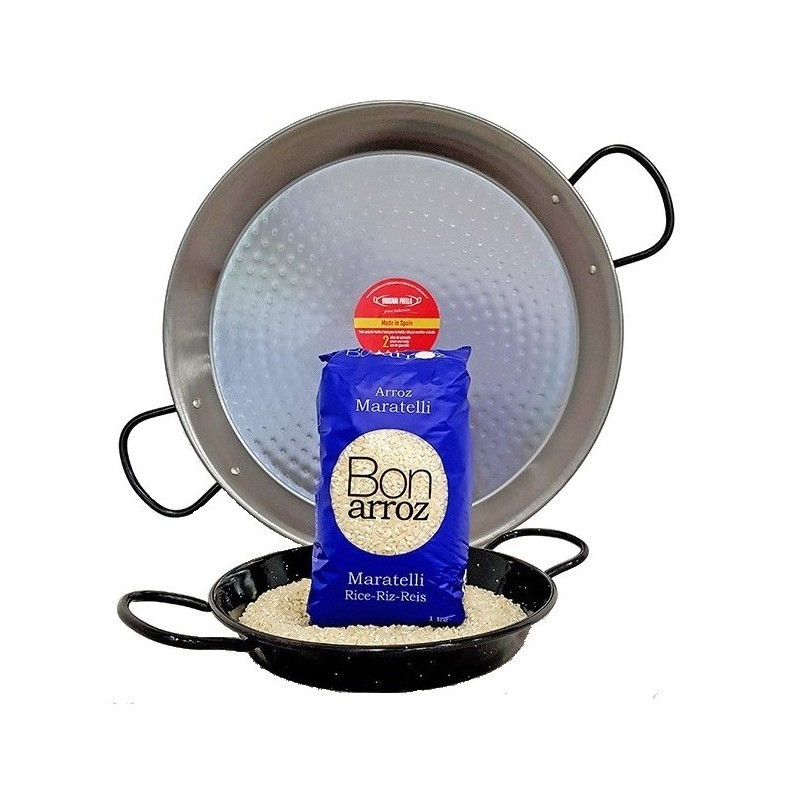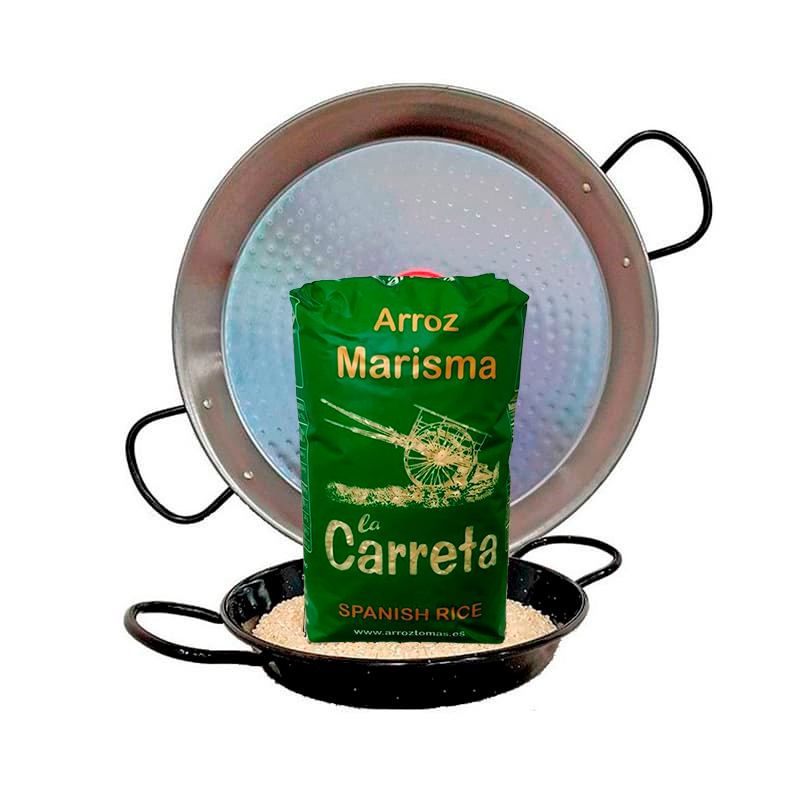TYPES OF RICE FOR PAELLA
TYPES OF RICE FOR PAELLA
In this blog entry we are going to analyze which is the best rice, it is a very recurring question among all our clients that has raised thousands of very lively debates on our social networks, such as Facebook, Twitter, Instagram or even Tik-Tok. Due to this, we have seen fit to create a page on our blog where we analyze the advantages and disadvantages, as well as the characteristics, of the different types of rice.
Let's go back to the question, what is the best rice? The answer to this question has a complex answer, affected to the extent that the rice is going to be better depending on the use to which we are going to put it, that is, it is not the same a recipe for dry rice or fine paella as for brothy rice or creamy rice, which is why there are varieties more suitable for one type of rice or another.
The same thing also happens with the time that passes from preparation to consumption, that is, a paella that we cook and start eating when it is made at home is not the same as a paella that is in process, such as in a restaurant menu, which is prepared at twelve and served until three, or in other similar ones such as catering, delivery or takeaway, where time passes from its preparation to its service.
The weaker rices in these cases will end up opening, while harder rices will be more recommended for other uses. What is important is to remember that there are frictions or prohibited varieties, that is, long rices. Long rice is not indicated for use on paellas and rice dishes because those long rice dishes tend to open at their ends and that is something undesirable in a paella.
The same happens with parboiled or pre-cooked rice, these rice, found in many generalist brands but which we prefer not to name, are rice that comes already pre-cooked, this is done to close the cuticle of the grain, which makes it a rice and a more resistant grain but at the same time the precaution that has been taken makes them have much less flavor, therefore they are rice that is easy to work with but with a much lower capacity to transfer the flavor than short or round rice, which are the that we have to use in our paellas.
The first of the questions that we usually see is which brand of rice is the best and the truth is that the difference between brands is minimal and is more reduced to quality parameters such as, for example, the percentage of broken grain or the freshness it may have. have the product that will mark the expiration date.
Honestly, there are not big differences between brands, we should keep in mind that, for example, in the lagoon, the different brands have plots that are next to each other, so insects pollinate without understanding plots or brands, that is to say, if a brand tried to defend the peculiarity of its seed, it would be a complex and expensive process which, in the long run, would not be worth it.
.jpg)
Genetically, the fourth generation between both seeds or all the seeds will be the same, therefore, it is difficult to defend the peculiarity of a brand, this also happens with the origins of the rice, 60% of the rice currently comes from Andalusia, from the banks of the Guadalquivir and Guadiana, it is therefore the largest rice producing area in Spain, followed by the Ebro delta with 15% and the Albufera de Valencia with 14%, then there are other areas that are also important but with smaller plantations such as Calasparra in Murcia or on the banks of the Ebro in Zaragoza.
In all these origins, high-quality rice is made and therefore the differences are not great. It is because of this that it is not a question of brand or origin where the main difference will be, it is in the variety where we find this main difference between rice
Now we will see the varieties, one piece of advice we give you is that the rice package should always include its origin, because if I have a provenance, I have a guarantee that the product has uniformity to the extent that it always comes from that origin, if it also has the designation of origin, even better.
There are generalist brands or white supermarket brands where we will not see the origin, this means that they can put the rice from the origin they want at their convenience, usually by price, and this makes it more difficult to get the exact cooking point that each one wishes with the rice, since it may happen that sometimes it is breaking in one place, other times it is broken in another or it will even be a mixture of all of them.
That said, let's analyze the different varieties of rice and we can find differences in them that have a scientific justification. There are more than 100,000 varieties of rice, so imagine the big differences there can be between varieties.
Taking this into account, let's look at, for example, the varieties of rice covered by the Valencian designation of origin, which are three:
- The first is the senia type variety, which includes different varieties such as Sendra Bahía, Senia Gleba and some other subspecies that are, therefore, interbred with each other.
- The second variety is Bomba rice, a variety that is well known and appreciated by rice farmers.
- The third, recently created, is albufera rice.
- We will add two trusted variations in this analysis, Maratelli rice and Marisma rice.
Senia Rice
.jpg)
Senia rice is characterized by having a very high productivity of around 7,500 kilograms per hectare, which means that the price is lower because we have high productivity.
It is a rice that is characterized by being a creamy and moist grain, both inside and outside, this humidity is what acts as a vehicle for the flavor, but at the same time it prevents the grains from separating easily, so grain looseness is lower.
It is a softer grain that does not tolerate overcooking well and therefore we should not exceed 16 minutes of cooking.
Due to this characteristic, it is therefore a rice that is intended for the use of experienced rice cooks, since it is cooked very easily and can suffer due to those processes between finishing cooking and consumption a short period of time passes.
Bomba Rice
.jpg)
Bomba rice has a low productivity, around 3,200 kilograms per hectare, that is, less than half that of senia rice, this causes its price to increase due to being somewhat more scarce.
The main advantage is that, thanks to its organoleptic characteristics, we get a more resistant rice that is easier to work with, it is more comfortable, but it also cooks longer because it has a harder round grain, its cooking time would be between 17 and 20 minutes.
This is a rice for rice cookers who are generally less experienced because it is easier to work or who are interested in the looseness of the rice grain being higher. It is also a grain that can be used for those who need to spend more time between cooking and the service, such as a paella from a catering restaurant menu or a takeaway delivery, this would be the most suitable rice.
Albufera Rice
.jpg)
Albufera rice is a variety that has been relatively recently created, genetically, it is a mix between Bomba rice and Senia rice and therefore it is a very interesting variant because it is halfway in terms of productivity, price, and hardness of the grain. and as a vehicle for flavor, as well as resistance to overcooking.
This type of grain results in a more organic compromise for those who are interested between hardness and flavor vehicle, which are the two main characteristics of rice.
Maratelli Rice

There are also other interesting varieties of rice that deserve mention, such as, for example, Marateli rice, a rice very similar to Bomba in terms of hardness and flavor vehicle but which has a higher productivity and therefore a lower price.
It is a very easy rice to work with, suitable for restaurant menus that we can prepare at 12 and be served after 3, or even reheat the rice, which allows us to use it up and maintain that desired hardness and flavor. It is a rice that we also use in businesses that have to do with delivery and takeaway, it can even be used with giant paellas.
Marisma Rice

Last but not least, we have the marisma rice, it is an intermediate-sized rice, which, unlike all the previous rices, which are short-grain rice, this will be the only intermediate-grain rice that we are going to see. which is a rice that perhaps in dry rice we are not used to seeing because there is a larger halo, even so, it is a type of rice that works very well for soupy and sticky rice and therefore we recommend it for this class of use.
What is the difference between all these rice types?
Even with all this information, the key to all these rice is found in the starch, it is the scientific explanation that indicates these different behaviors of the rice. Starch is a macromolecule, present in vegetables, which is the vehicle of glucose. In this macromolecule, in addition to glucose polymers, mimosa and less pectin coexist, which are those that give these differences and characteristics of rice.
For example, bomba rice is a rice rich in amides and has between 25 and 30% amylose, which makes it low in moisture, which means that the grain looseness is high. In another variant of a similar grain, such as the Marateli, it also provides that hardness to the grain.
At the other extreme we have senia rice, which is rich in amido pectin, so it has a high humidity and that means that the looseness is not as high as in bomba rice, in addition, amylopectin makes the resistance of the grain more low, which turns it into a rounder rice and therefore less resistant to overcooking.
After this review of all the Valencian varieties, in addition to some other ones that we also usually use, we hope that you have all the information to be able to decide which is your type of rice according to the situation.

In any case, rice enjoyers, if after all this explanation you are still not sure about the rice you want in your paella, you can try buying one of our 1 kilo package pack, try them all, and in the nearby future select the rice that you like the most.
If you want to learn more about which rice variety is best suited for your rice recipe, you can visit our blog post: Which rice variety is right for my recipe?
If you want to see more content from our blog, follow this link.



